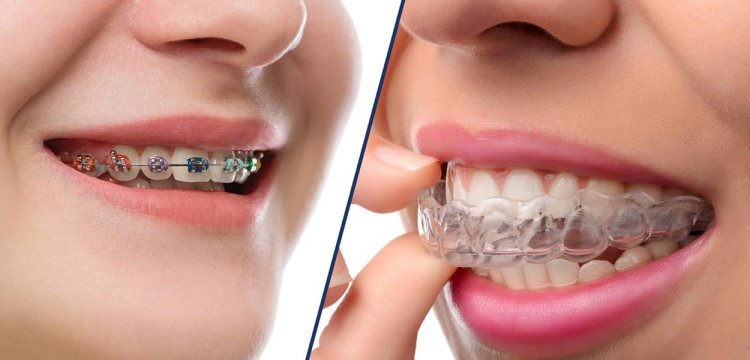Does Invisalign Really Work? The Truth About Its Effectiveness Compared to Braces
In this comprehensive guide, we will uncover the truth about Invisalign London, its benefits, potential drawbacks, and whether it's the right choice for you.

For decades, traditional metal braces were the go-to solution for straightening teeth. However, with the rise of modern orthodontic treatments, Invisalign has become a popular alternative. Many people wonder: does Invisalign really work? And how does it compare to traditional braces in terms of effectiveness? In this comprehensive guide, we will uncover the truth about Invisalign London, its benefits, potential drawbacks, and whether it's the right choice for you.
Understanding Invisalign: What Is It and How Does It Work?
Invisalign is a brand of clear aligners that offers a discreet and convenient way to straighten teeth. Unlike traditional braces that use metal brackets and wires, Invisalign consists of custom-made, transparent plastic trays that gradually shift teeth into the desired position. These aligners are removable and need to be worn for 20-22 hours a day for optimal results.
The process begins with a consultation with an orthodontist, who takes digital impressions of your teeth. These images are used to create a personalised treatment plan, mapping out the step-by-step movement of your teeth. Every one to two weeks, you switch to a new set of aligners, gradually guiding your teeth into proper alignment over time.

Effectiveness of Invisalign vs. Traditional Braces
1. Treatment Scope: What Can Each Correct?
-
Invisalign is highly effective for mild to moderate cases of misalignment, including crowded teeth, gaps, and minor bite issues (overbite, underbite, crossbite).
-
Braces are better suited for more complex dental issues, such as severe crowding, deep bites, rotated teeth, and large gaps. They offer greater control over tooth movement, making them ideal for challenging orthodontic cases.
2. Treatment Duration: Which Works Faster?
-
Invisalign treatment typically takes 12 to 18 months, depending on the complexity of the case and patient compliance.
-
Traditional braces usually require 18 months to 3 years for full correction. While braces may take longer, they are constantly working since they are fixed and cannot be removed.
3. Convenience and Comfort
-
Invisalign aligners are removable, allowing users to eat and drink without restrictions. However, aligners must be cleaned regularly and worn diligently to ensure effectiveness.
-
Braces cannot be removed and may cause discomfort due to wires and brackets. Patients may experience irritation, soreness, and occasional breakages requiring emergency orthodontic visits.
4. Aesthetics: The Clear Advantage of Invisalign
One of the biggest reasons people choose Invisalign is aesthetics. The clear aligners are nearly invisible, making them an attractive option for adults and teens who want a discreet orthodontic solution. In contrast, traditional braces are highly noticeable due to metal brackets and wires, though ceramic or lingual braces offer slightly less visibility.
5. Oral Hygiene: Which Option is Easier to Maintain?
-
Invisalign allows for better oral hygiene since the aligners are removable. You can brush and floss as usual without navigating around brackets and wires.
-
Braces require extra effort to maintain good oral hygiene, as food particles often get stuck between brackets and wires, increasing the risk of cavities and gum disease.
Potential Drawbacks of Invisalign
While Invisalign offers numerous benefits, it does come with some limitations:
-
Not Suitable for Severe Cases: Invisalign may not be effective for complex orthodontic cases requiring significant tooth movement.
-
Requires Discipline: Since aligners are removable, patients must be committed to wearing them for at least 22 hours a day. Failure to do so can delay treatment progress.
-
Can Be Costlier: Invisalign tends to be more expensive than traditional braces, depending on the case and the provider.
-
Speech Adjustment: Some users experience a slight lisp when first wearing Invisalign, but this usually resolves within a few days.
Who Should Choose Invisalign?
Invisalign is an excellent choice for:
-
Adults and teenagers looking for a discreet orthodontic solution.
-
Individuals with mild to moderate dental misalignment.
-
Those who can commit to wearing aligners for the required amount of time.
-
Patients who prioritise comfort and convenience over cost.
Who Should Consider Traditional Braces?
Braces are ideal for:
-
People with severe misalignment or bite issues.
-
Children and teenagers who may struggle with compliance in wearing aligners.
-
Patients looking for a lower-cost option.
-
Those who don’t mind the visibility of metal braces in exchange for effective treatment.
Does Invisalign Really Work?
Yes, Invisalign is a highly effective orthodontic treatment for many individuals, especially those with mild to moderate misalignment. It offers a discreet, comfortable, and convenient alternative to traditional braces. However, for complex cases, traditional braces may still be the best choice.
The key to success with Invisalign—or any orthodontic treatment—is choosing the right provider and following the treatment plan diligently. If you're considering Invisalign, consult with a qualified orthodontist to determine whether it's the best solution for your unique dental needs.
Final Thought
Whether you choose Invisalign or traditional braces, the end goal is the same: a healthier, straighter smile. Consider your lifestyle, budget, and orthodontic needs before making a decision, and trust your orthodontist’s expertise to guide you toward the best outcome.
What's Your Reaction?




















